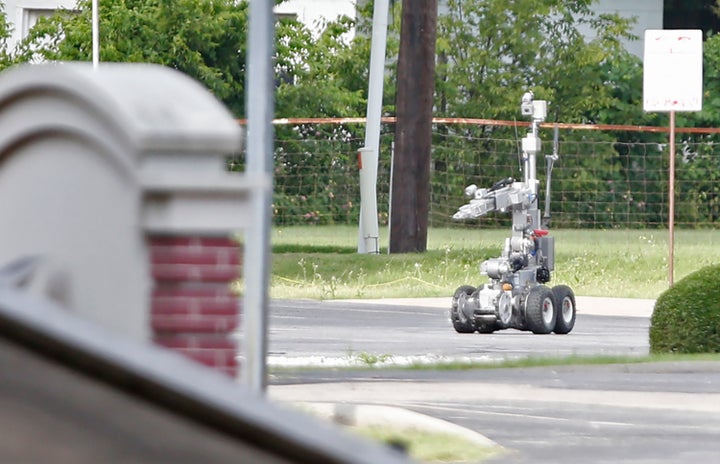
For perhaps the first time, police in the United States used a remote-controlled robot to engage and kill a suspect Thursday following a tense standoff in Dallas, Texas.
The robot deployed in Dallas is normally used to disarm explosives, Mashable reported, but police outfitted it with a bomb that was delivered to the suspect and detonated.
“We saw no other option but to use our bomb robot and place a device on its extension for it to detonate where the suspect was,” Dallas Police Chief David Brown told the outlet.
“The robot wasn't a drone, wasn't autonomous and wasn't originally designed to kill anyone.”
Both the Dallas County Sheriff and the Federal Bureau of Investigation in Dallas use a type of robot called Marcbot-IV, according to a database operated by Bard College. These devices are explicitly created to dispose of explosives.
They look like this:
The Dallas Police Department did not immediately respond to a request for more details from The Huffington Post. Meanwhile, a report from Popular Science indicated that the Dallas Police Department used a different type of bomb disposal robot, called a “Remotec,” to access an armored van during a standoff last year. Over 90 percent of police bomb squad units use Remotecs, a spokesman for Northrop Grumman, the military technology company behind the robot, told Vice last year.
Northrop Grumman declined to comment when reached by HuffPost.
Whether the robot in this case was a Marcbot-IV or Remotec, it’s worth reiterating a couple of things: The robot wasn’t a drone, wasn’t autonomous and wasn’t originally designed to kill anyone. You could think of it like a really big, really complex Tyco R/C car.
As Quartz Technology Reporter Mike Murphy put it:
Still, the fact remains that the police deployed a robot with the intent to kill a suspect, which some say sets a worrying precedent about lethal force that’s completely separate from the ethical considerations of shooting a gun.
“The legal framework for police use of force assumes human decision-making about immediate human threats,” Elizabeth Joh, a professor of law specializing in policing and technology at the University of California Davis, told HuffPost. “What does that mean when the police are far away from a suspect posing a threat? What does ‘objectively reasonable’ lethal robotic force look like?”
Joh recognizes that this wasn’t a complex killing machine, but she argues its deployment indicates how easy it would be for police to launch more advanced weaponry without oversight. After all, they transformed a bomb disposal robot into a bomb delivery robot.
“This seems to be a jury-rigged robot. What happens when a police department buys the first AI police robot capable of lethal force? No clear answers, but the future’s already here,” Joh said.
Some have made the case that robots with the capacity to kill could actually help save lives. In an interview with HuffPost last month, noted robotics expert Ronald Arkin said these autonomous weapons could theoretically be used to protect people in certain situations.
“The hope is that if these systems can be designed appropriately and used in situations where they will be used appropriately; that they can reduce collateral damage significantly,” Arkin told HuffPost at the time.
More details are sure to emerge about the Dallas “robot bomb,” but one thing’s certain: It’s worth addressing the ethical concerns now, before these machines are rolling through our streets or floating through the skies.

